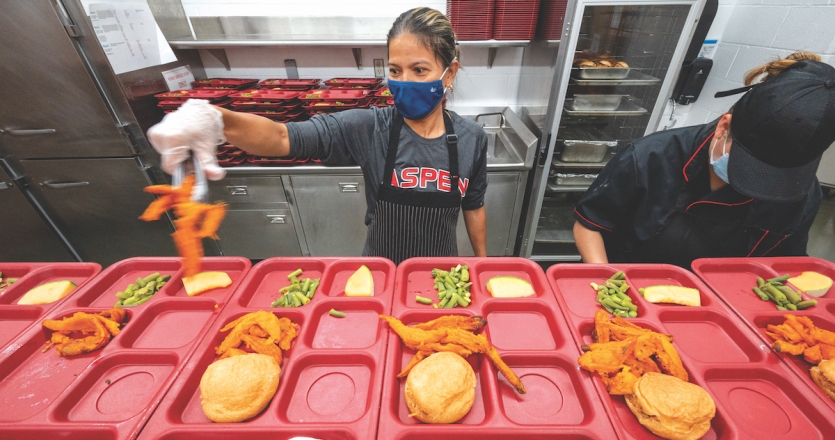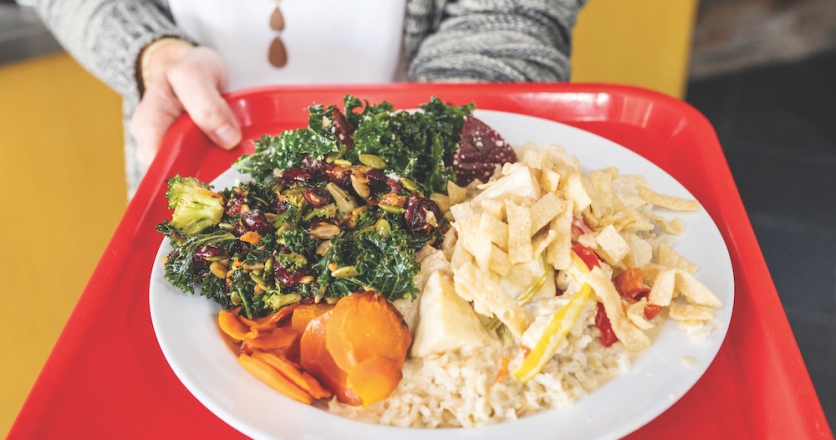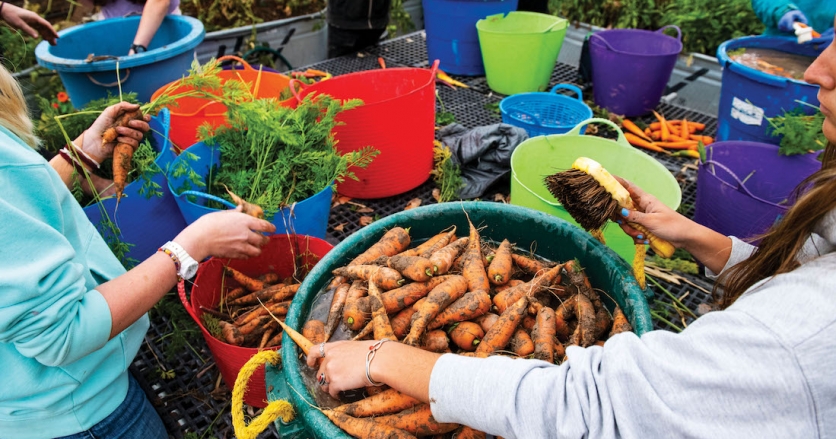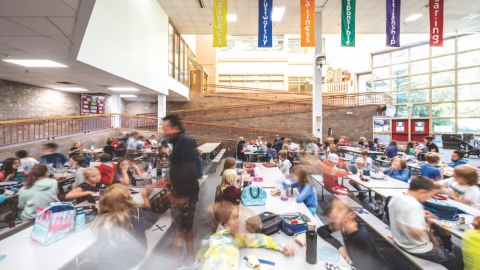Daily Lunch, Lifelong Habits
During Alex Appleby’s valedictorian speech in June, the robotics fanatic gave the audience some advice. Topping the list? “Savor every curry day,” he said. “I speak for the students and faculty alike when I say that curry day is truly a sacred time in the Aspen High School commons.”
Curry day is posted about once a month on the school’s lunch menu. It’s served with chicken or potatoes and comes with rice. It’s not typical for school lunches to get a shout out in graduation speeches, but the Aspen School District food program isn’t typical. It’s only in the past four years that Aspen High School students have benefitted from Food Service Director Tenille Folk’s touch, but elementary and middle school students have been tasting the benefits for more than a decade.
The secret ingredient?
“Love,” says Folk. “You see kids come running through the commons for curry day. You see the kids excited for real food.”
Folk’s mantra is essentially that: “We cook as much as we can. Real food is what we try to do. If you just cook real food, that’s what the kids want.”
It seems simple enough. The USDA’s National School Lunch Program is increasingly trying to adopt the same mission, but what can be achieved in a small district of 1,645 students is far different from the fare served to 30 million who eat in school cafeterias across the country. It’s not just size; socioeconomic levels, food access, and culture all play a part too. In the Roaring Fork Valley, these factors affect food trays from Aspen to Rifle.
Fresh and homemade
Folk joined the Aspen School District in 2009. She previously chefed in Aspen kitchens including the St. Regis and Lulu Wilson. When she started a family, she wanted a schedule that was more conducive to being with her young children, and an opportunity with the Aspen School District opened up. She brings a background of creative restaurant cooking and combines it with an ethos of nutritious home cooking—two characteristics traditionally absent from mainstream school menus.
“In elementary [where students are not allowed to leave campus for lunch] we have more control, with fruit, veggies, and home-cooked meals,” she says. “In middle school we start to expand and give them more options and hope they make healthy choices. [At the high school], because it’s an open campus, we are competing with trying to keep students on campus for lunch. They get even more options to choose from—including grab-and-go options from this café, which is open every day, all day—and they just eat all day long.”
In the elementary school, about 300 students per day buy hot lunch, paying $4.50 per meal. Another 250 buy lunch in the middle school, where it costs $5. Before 2016, the high school was serviced by a third-party contractor, but the district board and the school’s wellness committee made the decision to move its food program in house as well. Now, 150 high school students eat hot lunch (for $6, which includes a salad bar) and another 300 grab sandwiches, wraps, and snacks from the à la carte café, where items like French fries, candy, and soda are conspicuously absent. In their place: house-made granola, hummus, and Naked juices. She estimates that 5 to 10 percent of the district’s students qualify for free or reduced-price lunches.
Folk tries to use local food when possible, sourcing at least 10 percent through Mountain Freshies, a wholesale service collecting produce from North Fork Valley farms. (Due to COVID-19 and a staffing shortage, an on-campus garden she started years ago is currently not producing food for school kitchens.) Her philosophy on prepared food is fresh and real, which often makes it healthy too. For example, school chefs craft nacho cheese from butternut squash purée, and the house pizza sauce includes tomatoes, onions, carrots, celery, yellow squash, zucchini, red peppers, and basil.
“We have some kids who get the whole hot lunch and then ask for another second plate for the salad bar,” says Folk. “Whereas in the elementary school, we are struggling just to encourage them to take their carrot sticks sometimes. We put it on their plate anyway just to get the exposure.”
Unlimited fruits and veggies
That awareness is a priority for Octavio Maese, director of nutrition services for the Roaring Fork School District; it’s also part of his mandate from the Colorado Department of Education and the National School Lunch Program. Whereas Aspen School District’s $745,000 budget for the 2021–22 school year comes from the district’s general fund, Roaring Fork’s food budget is federally funded—the government reimburses the district on a per-meal basis every month. (Because of a federal waiver for COVID-19, all meals this school year are offered free to students.) Roaring Fork School District relies on federal funding because it has a large number of students who qualify for free and reduced-price lunch, which the government reimburses. Along with that financial support comes regulations.
“The USDA sets forth nutritional guidelines that we have to meet on a weekly basis,” says Maese. “We have to have hot meat and vegetarian entrées, such as beef nachos and cheese nachos. We offer fresh fruits and vegetables every day. [The selection is] not as robust as I would like it to be or have experienced in the past, and because of COVID we have to pre-package all of our fruits and vegetables. So, we’ll pre-portion things like peaches and broccoli—but there is no limit on fruits and vegetables for students.”
As part of the Healthy, Hunger-Free Kids Act of 2010, a law signed by President Obama and promoted by then-First Lady Michelle Obama, school lunch requirements were updated to include almost double the amount of fruits and vegetables, among other changes.
Maese ensures these guidelines are met for the 2,400 students who eat hot lunch across 13 schools from Basalt to Glenwood Springs. “To be able to provide these fruits and vegetables, even though they’re not all from Colorado or organic, a fresh fruit or vegetable is much better than not having it at all,” he says. “That we’re continuing to offer those choices is huge.”
Farm to table, directly
Since 2013, the USDA has also had a Farm to Schools program, granting funds to provide schools with local food. But it’s not just outside funding that makes local sourcing happen in Roaring Fork Valley schools. In fact, at Colorado Rocky Mountain School, the farm providing produce is run by the school itself and integrated into its curriculum.
“Our mission is a production garden,” says Heather McDermott, director of the CRMS garden program. “We produce a lot of food, and our customer is the dining hall. We feed students three meals a day, as well as the staff and community.”
The private boarding and day college-prep school sits on 300 acres straddling the Roaring Fork River. Part of that land—a historic ranch—has been converted into gardens, an effort that McDermott has ramped up in her six years at the helm. The gardens provide about 40 percent of the produce that the kitchen uses year round, feeding roughly 200 people daily during the school year. “We can’t meet all their needs, but we take a big chunk out of it,” she says.
Last year, the school harvested 3,000 pounds of onions, which they were able to store in a root cellar and use throughout the year. Because there are fewer students on campus during the summer, when the produce starts to peak, McDermott has to balance growing preservable items with those that can be eaten during August, September, and October when there’s an abundance of food. Some vegetables and fruits can be frozen for use throughout the year, or made into sauces like pesto and marinara. In the summer, excess produce is donated to Lift-Up; this summer, more than 500 pounds of zucchini and cucumber were given to the food pantry.
Feeding the staff and students is important, but so is the process of learning how to grow food. CRMS students participate in a variety of service programs—many sign up for garden work. With an on-campus greenhouse, this engagement can happen throughout the school year, and it includes seeding and prepping for the school’s annual community spring plant sale, which nets $15,000 from growing and selling more than 8,000 plants. Additionally, the garden weaves into various curricula: Biology students study soil science and composting, health classes study nutrition, and photography students have an image treasure trove. “When you’re a part of the food that you’re eating—when you’re outside digging potatoes and the next day you turn around and eat them—you have a greater appreciation for the food,” says Stella Guy Warren, a senior at CRMS.
Even though Warren is a day student and Carbondale resident, she eats lunch every day on campus and often dinner too. “I think it’s easy to not know where your food is coming from and just show up to eat,” she says.
Warren’s appreciation is palpable, but not every student develops that while at school.
“Students who have gone here then go on to come back and say, ‘This is where I started gardening,’” says McDermott. “It is a more mature thing. But let’s get kids to try to get this concept early instead of only appreciating once they leave.”
Across all three school entities, food and nutrition awareness is key. Yes, eating healthy is paramount and has immediate effects on kids’ learning habits. But creating healthy habits for a lifetime is the long-term goal.
“One of the best things about my job is seeing kids as kindergarteners, and now they’re all graduating,” says Folk. “It’s really cool to see them develop and learn to appreciate food all along the way.”
That gratitude may come in the form of a graduation speech. Often, it’s more nuanced. Smiles, thank yous, and second helpings are all tokens of encouragement. But the greatest satisfaction comes in knowing that students are well fed—with real food.









